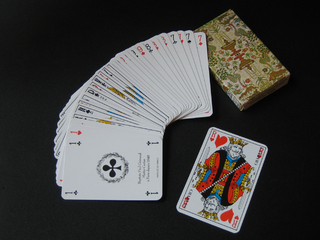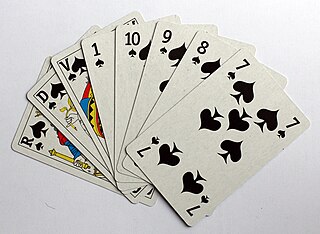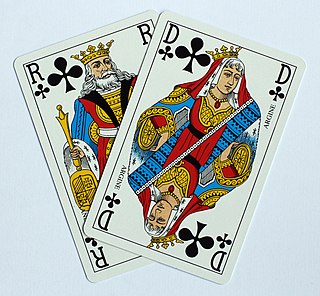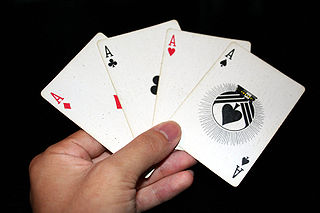
Bezique or bésigue is a 19th-century French melding and trick-taking card game for two players that came to Britain and is still played today. The game is derived from piquet, possibly via marriage (sixty-six) and briscan, with additional scoring features, notably the peculiar liaison of the Q♠ and J♦ that is also a feature of pinochle, Binokel, and similarly named games that vary by country.
Marjapussi is a traditional Finnish trick taking game for 4 players playing in 2 partnerships and is one of the Mariage family, its key feature being that the trump suit is determined in the middle of the play by declaring a marriage. There are variants of marjapussi for two and three players.
Pedro is an American trick-taking card game of the all fours family based on auction pitch. Its most popular variant is known as cinch, double Pedro or high five which was developed in Denver, Colorado, around 1885 and soon regarded as the most important American member of the all fours family. Although it went out of fashion with the rise of auction bridge, it is still widely played on the western coast of the United States and in its southern states, being the dominant game in some locations in Louisiana. Forms of the game have been reported from Nicaragua, the Azores, Niobe NY, Italy, and Finland. The game is primarily played by four players in fixed partnerships, but can also be played by 2–6 individual players.

Quadrille is a card game that was highly popular in the 18th century at the French court and among the British nobility, especially women. A variant of the three-player, Spanish card game Ombre, it is played by four players, both in varying alliances and solo games, using a pack of 40 cards. Developed in southern France in the late 17th century, it took off in Paris and London in the early 19th century, it being "to the good taste of the French nation" and to women, principally of the middle and upper classes, among whom it became their favourite game. Having become "one of the great European games for about a hundred years" by the mid-19th century, Quadrille had fallen out of fashion, superseded by Whist and Boston.

Brusquembille or Briscambille is a historical, French, 3-card trick-and-draw game for two to five players using a 32-card piquet pack. The game has variable trumps. Side-payments are made for keeping or winning aces and tens.

Bestia is an Italian card game. It is a gambling game and is similar to Briscola and Tressette. The word bestia means beast.

Aluette or Vache ("Cow") is an old, plain trick-taking card game that is played on the west coast of France. It is played by two teams, usually of four people, but sometimes also of six. It is unusual in using a unique pack of 48 Spanish playing cards and a system of signalling between playing partners. The French colloquial names for the game, jeu de la Vache or Vache, refer to the cow depicted on one of the cards.

Triomphe, once known as French ruff, is a card game dating from the late 15th century. It most likely originated in France or Spain and later spread to the rest of Europe. When the game arrived in Italy, it shared a similar name with the pre-existing game and deck known as trionfi; probably resulting in the latter becoming renamed as Tarocchi (tarot). While trionfi has a fifth suit that acts as permanent trumps, triomphe randomly selects one of the existing four suits as trumps. Another common feature of this game is the robbing of the stock. Triomphe became so popular that during the 16th century the earlier game of trionfi was gradually renamed tarocchi, tarot, or tarock. This game is the origin of the English word "trump" and is the ancestor of many trick-taking games like Euchre and Whist. The earliest known description of Triomphe was of a point-trick game, perhaps one of the earliest of its type; later, the name was applied to a plain-trick game.

Solo 66 is a trick-taking ace–ten card game for five players, in which a soloist always plays against the other four. It is based on the rules of Germany's national game, Skat, and is played with a French-suited Skat pack of 32 cards. Bidding is for the trump suit. Jacks are ranked within their respective suits and do not form additional trumps over and above the cards of the trump suit. Grupp describes it as "an entertaining game for a larger group."

Mistigri, historically Pamphile, is an old, French, trick-taking card game for three or four players that has elements reminiscent of poker. It is a member of the Rams family of games and, although it is a gambling game, often played for small stakes, it is also suitable as a party game or as a family game with children from the age of 12 upwards.

Briscan is an 18th-century, French ace–ten card game for two players played with a 32-card piquet pack. It is a member of the marriage group of games in which the 'marriage' of a king and queen brings a bonus score, but briscan takes this simple concept to extraordinary lengths.

Brisque is an 18th-century, French ace–ten card game for two players played with a 32-card piquet pack. It is a member of the marriage group of games in which the 'marriage' of a king and queen earns a bonus.

Bête, la Bête, Beste or la Beste, originally known as Homme or l'Homme, was an old, French, trick-taking card game, usually for three to five players. It was a derivative of Triomphe created by introducing the concept of bidding. Its earlier name gives away its descent from the 16th-century Spanish game of Ombre. It is the "earliest recorded multi-player version of Triomphe".

The game of Nain Jaune or Yellow Dwarf, also formerly called Lindor, is an "attractive and unique traditional French card game" using a board comprising five compartments or boxes. It is a reasoned game of chance because it combines the hazards of card distribution with the strategy of building suits. Nain Jaune, which is considered a classic French game, is named after the seven of diamonds, which is depicted as a yellow dwarf in the centre of the game board.

Coucou ("Cuckoo") is an historical French card game that uses a pack of 32 or 52 cards and is played by five to twenty players. It is unusual for being played with only a single card in hand. As a shedding game, there is only one winner who may claim the stakes, if there are any. The game has also been called As Qui Court or Hère.

Culbas or Cul-bas is an historical French card game of the fishing type for three to eight players that dates to at least the 17th century. It is described as being "very old" and having "a great simplicity in which chance plays the biggest role."

Quarante de Roi or Quarante de Rois is an historical French, point-trick, card game for four players in partnerships of two. The name comes from its highest scoring combination of four Kings which is worth 40 points.

Romestecq is an historical Dutch card game for two, four or six players in two teams that dates to at least the 17th century. It was also popular in France for over a century. Despite being criticised in contemporary sources as "complicated" it continued to appear in the literature until the end of the 19th century and was sufficiently interesting for it to appear in The Penguin Book of Card Games in 2008.

Papillon is an old French card game of the fishing type for three or four players. It has been described as "perfect for children who know how to count".

Sizette is an historical French card game for six players in two teams of three. It is unusual in that communication between partners is allowed and the team captain is permitted to ask for information and direct play. It has been described as one of the most enjoyable games of cards, albeit one requiring skill to play well. It is a form of Whist for six players.















